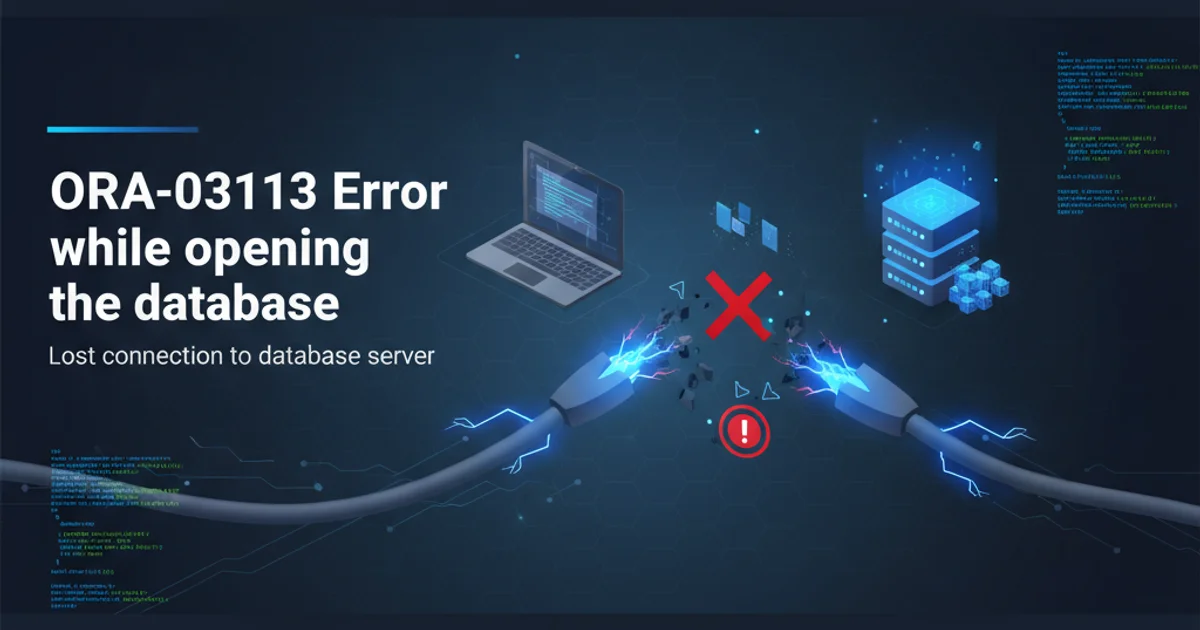ORA-03113 Error while opening the database
Categories:
Troubleshooting ORA-03113: End-of-file on communication channel

Understand the common causes and effective solutions for the ORA-03113 error in Oracle databases, often indicating a lost connection to the database server.
The ORA-03113 error, "end-of-file on communication channel," is a common and often frustrating Oracle database error. It typically signifies that the client process has lost its connection to the Oracle database server process. This can happen for a variety of reasons, ranging from network issues to server-side crashes or resource exhaustion. This article will delve into the common culprits behind ORA-03113 and provide a structured approach to diagnose and resolve it, ensuring your Oracle 11g database remains stable and accessible.
Understanding the ORA-03113 Error
At its core, ORA-03113 means that the client application (e.g., SQL*Plus, an application server, or a custom program) was communicating with the Oracle database server, but the connection was abruptly terminated. The 'end-of-file' part refers to the client receiving an unexpected end-of-stream from the server, indicating that the server process it was connected to is no longer available or responsive. This is not an error generated by the database itself in response to a SQL statement, but rather a communication error at a lower level.
sequenceDiagram
participant Client
participant Network
participant DatabaseServer
Client->>Network: SQL Query
Network->>DatabaseServer: SQL Query
DatabaseServer-->>Network: Query Result (or processing)
Note over DatabaseServer: Server process terminates unexpectedly
Network--xClient: Connection reset/closed
Client->>Client: Detects ORA-03113Sequence diagram illustrating the ORA-03113 error scenario
Common Causes and Diagnostic Steps
Diagnosing ORA-03113 requires a systematic approach, as the error message itself is generic. The key is to look for symptoms on both the client and server sides, and to check various layers of the infrastructure. Here are the most common causes and how to investigate them:
alert_<ORACLE_SID>.log) and listener log (listener.log) on the database server first. These logs often contain critical information about server-side issues that precede the ORA-03113 error on the client.1. 1. Network Connectivity Issues
A common cause is an unstable or broken network connection between the client and the database server. This could be due to faulty cables, misconfigured network devices, firewalls, or network congestion.
Diagnosis:
- Use
pingandtraceroute(ortracerton Windows) from the client to the server to check basic connectivity and latency. - Check network device logs (switches, routers, firewalls) for errors or dropped connections.
- Verify firewall rules are not prematurely closing connections (e.g., idle timeouts).
- Test with a simple SQL*Plus connection from the database server itself (if possible) to rule out network issues.
2. 2. Database Server Process Termination
The server process handling the client's connection might have crashed or been terminated. This is often the most serious cause.
Diagnosis:
- Check the Oracle Alert Log: This is paramount. Look for ORA-00600 (internal error), ORA-07445 (core dump), ORA-04030 (out of process memory), or ORA-04031 (shared pool/PGA exhaustion) errors around the time the ORA-03113 occurred. These indicate a database crash or severe resource issue.
- Check OS Logs: Review system logs (e.g.,
/var/log/messageson Linux, Event Viewer on Windows) on the database server for any OS-level errors, memory issues, or unexpected reboots. - Resource Monitoring: Monitor CPU, memory, and I/O utilization on the database server. High resource usage can lead to process termination.
3. 3. Listener Issues
While less common for an established connection, listener problems can sometimes manifest as ORA-03113 if the listener terminates or becomes unresponsive during connection handoff.
Diagnosis:
- Check Listener Status: Use
lsnrctl statuson the database server. - Check Listener Log: Review
listener.logfor errors or unexpected shutdowns.
4. 4. Client-Side Issues
Less frequently, the problem can originate from the client application itself, such as a client-side crash or resource exhaustion.
Diagnosis:
- Client Application Logs: Check logs of the application experiencing the error.
- Client OS Logs: Review system logs on the client machine.
- Test with SQL*Plus: Try to reproduce the error using a simple SQLPlus connection from the same client machine. If SQLPlus works, the issue might be specific to the application.
Resolving ORA-03113
Once you've identified the root cause, applying the appropriate solution is straightforward. Here are common resolutions based on the diagnostic steps:
1. 1. Address Network Problems
If network issues are suspected:
- Stabilize Network: Replace faulty cables, reconfigure network devices, or address congestion.
- Firewall Configuration: Adjust firewall rules to allow persistent connections and disable aggressive idle timeouts for database traffic.
- Increase SQLNET.EXPIRE_TIME: In
sqlnet.oraon the server, setSQLNET.EXPIRE_TIME = <minutes>(e.g.,10). This sends a small probe to check connection validity, preventing idle connections from being silently dropped by firewalls. Note: This adds minor network overhead. - Client-Side Keepalives: Configure TCP keepalive settings on the client OS if network devices are aggressively closing idle connections.
2. 2. Resolve Database Server Issues
If the alert log indicates a database crash or resource exhaustion:
- Analyze Alert Log Errors: For ORA-00600, ORA-07445, or ORA-04030/04031, consult Oracle Support with the full error stack and trace files. These often require patches or specific configuration adjustments.
- Increase Memory Parameters: If ORA-04030/04031 (memory exhaustion) is the cause, increase
SGA_TARGET,PGA_AGGREGATE_TARGET, or specific memory components as needed. Use AWR/ADDM reports to identify memory bottlenecks. - Tune SQL Statements: Inefficient SQL queries can consume excessive resources, leading to server process termination. Identify and tune problematic queries.
- Apply Patches: Ensure your Oracle database is patched to the latest recommended patch set update (PSU) or critical patch update (CPU) for your version, as many bugs are fixed in later releases.
3. 3. Restart Listener and Database
If the listener or database was down or unresponsive:
- Restart Listener:
lsnrctl stopfollowed bylsnrctl start. - Restart Database: If the database instance crashed, restart it using
startupin SQL*Plus (after connecting asSYSDBA).
SQL> connect sys/password as sysdba
Connected.
SQL> shutdown immediate;
Database closed.
Database dismounted.
ORACLE instance shut down.
SQL> startup;
ORACLE instance started.
Total System Global Area 167772160 bytes
Fixed Size 2210840 bytes
Variable Size 92276520 bytes
Database Buffers 67108864 bytes
Redo Buffers 6175744 bytes
Database mounted.
Database opened.
Example of restarting an Oracle database instance using SQLPlus.*